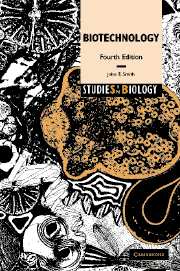Book contents
- Frontmatter
- Contents
- Preface
- 1 The nature of biotechnology
- 2 Substrates for biotechnology
- 3 Genetics and biotechnology
- 4 Bioprocess/fermentation technology
- 5 Enzyme technology
- 6 Biological fuel generation
- 7 Single cell protein (SCP)
- 8 Biotechnology and medicine
- 9 Environmental biotechnology
- 10 Biotechnology in the agricultural and forestry industries
- 11 Food and beverage biotechnology
- 12 Protection of biotechnological inventions
- 13 Safety in biotechnology
- 14 Public perception of biotechnology: genetic engineering – safety, social, moral and ethical considerations
- 15 Looking to the future
- Glossary
- Further reading
- Index
4 - Bioprocess/fermentation technology
Published online by Cambridge University Press: 05 June 2012
- Frontmatter
- Contents
- Preface
- 1 The nature of biotechnology
- 2 Substrates for biotechnology
- 3 Genetics and biotechnology
- 4 Bioprocess/fermentation technology
- 5 Enzyme technology
- 6 Biological fuel generation
- 7 Single cell protein (SCP)
- 8 Biotechnology and medicine
- 9 Environmental biotechnology
- 10 Biotechnology in the agricultural and forestry industries
- 11 Food and beverage biotechnology
- 12 Protection of biotechnological inventions
- 13 Safety in biotechnology
- 14 Public perception of biotechnology: genetic engineering – safety, social, moral and ethical considerations
- 15 Looking to the future
- Glossary
- Further reading
- Index
Summary
Introduction
Bioprocess or fermentation technology is an important component of most ‘old’ and ‘new’ biotechnology processes and will normally involve complete living cells (microbe, mammalian or plant), organelles or enzymes as the biocatalyst and will aim to bring about specific chemical and/or physical changes in organic materials (the medium). In order to be viable in any specific industrial context, bioprocessing must possess advantages over competing methods of production such as chemical technology. In practice, many bioprocessing techniques will be used industrially because they are the only practical way in which a specific product can be made (e.g. vaccines, antibiotics).
The very beginnings of fermentation technology, or as it is now better recognised, ‘bioprocess technology’, were derived in part from the use of microorganisms for the production of foods such as cheeses, yoghurts, sauerkraut, fermented pickles and sausages, soy sauce, and other Oriental products, and beverages such as beers, wines and derived spirits (Table 4.1). In many cases, the present-day production processes for such products are still remarkably similar. These forms of bioprocessing were long viewed as arts or crafts but are now increasingly subjected to the full array of modern science and technology. Paralleling these useful product formations was the identification of the roles that microorganisms could play in removing obnoxious and unhealthful wastes, which has resulted in worldwide service industries involved in water purification, effluent treatment and solid waste management (Chapter 9).
Information
- Type
- Chapter
- Information
- Biotechnology , pp. 52 - 75Publisher: Cambridge University PressPrint publication year: 2004
